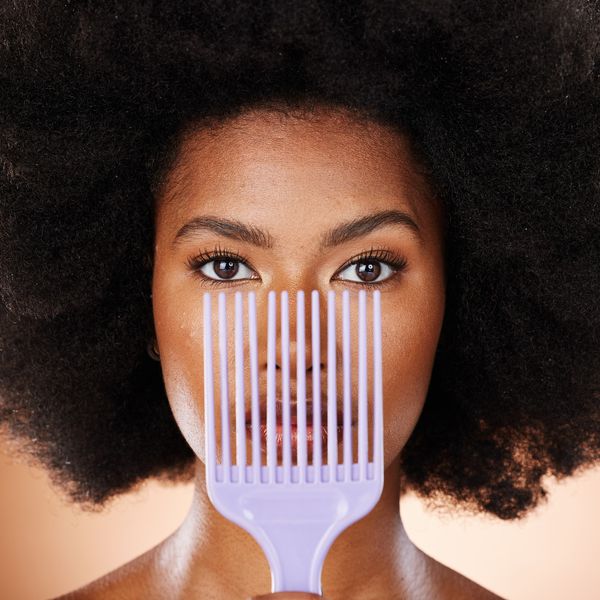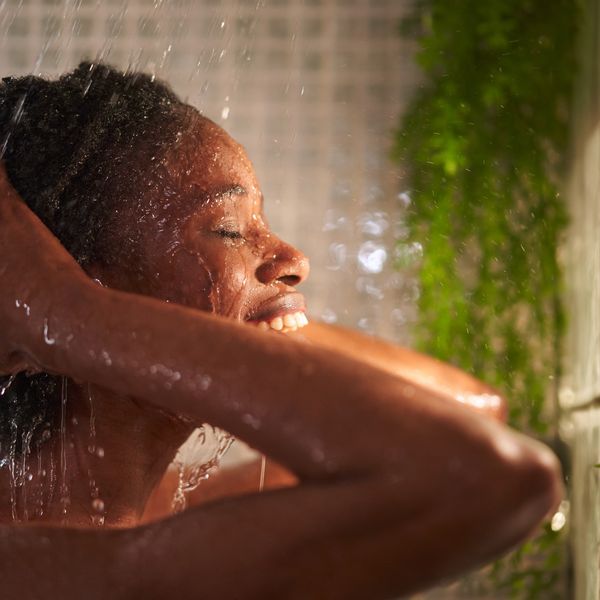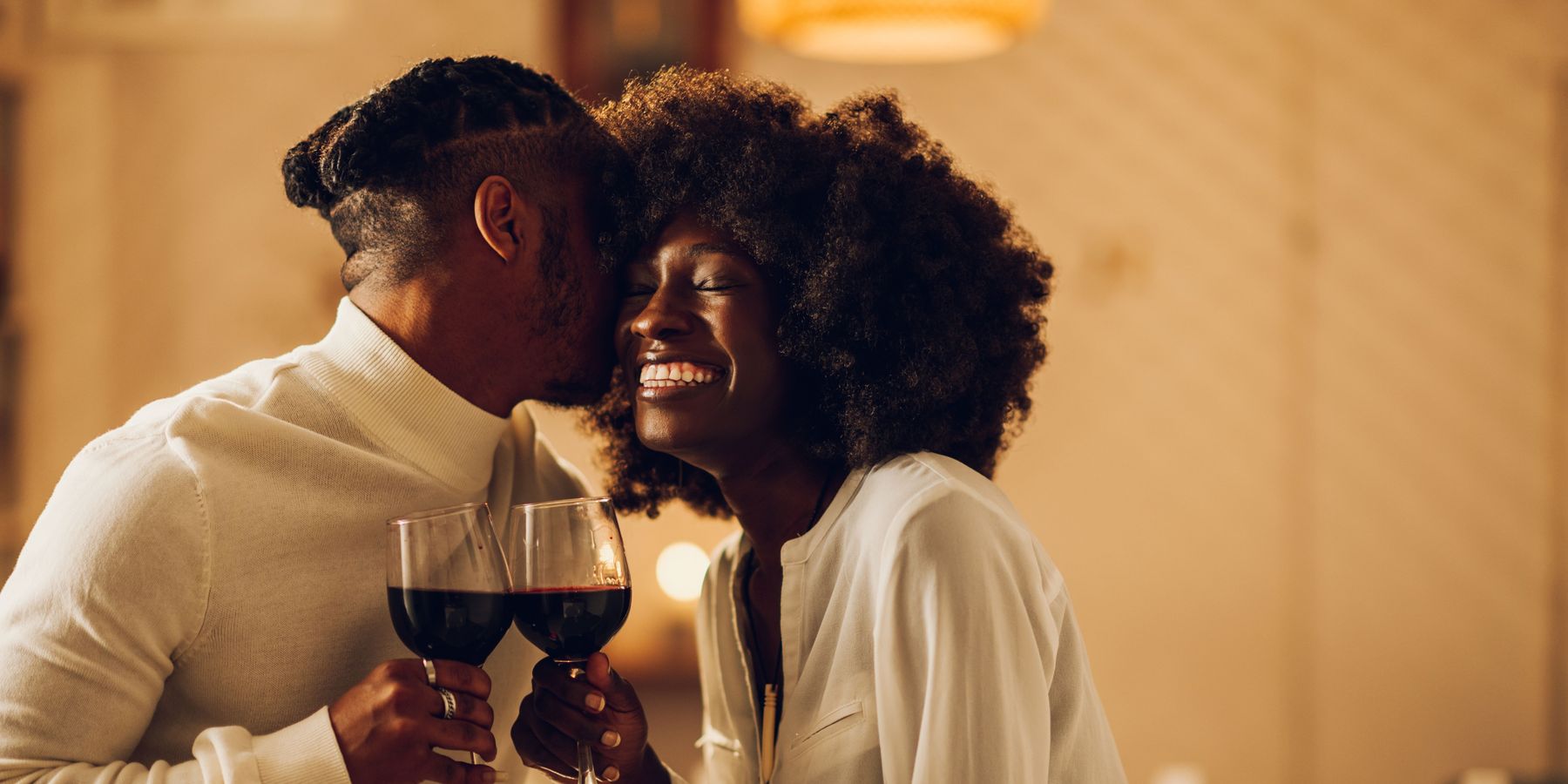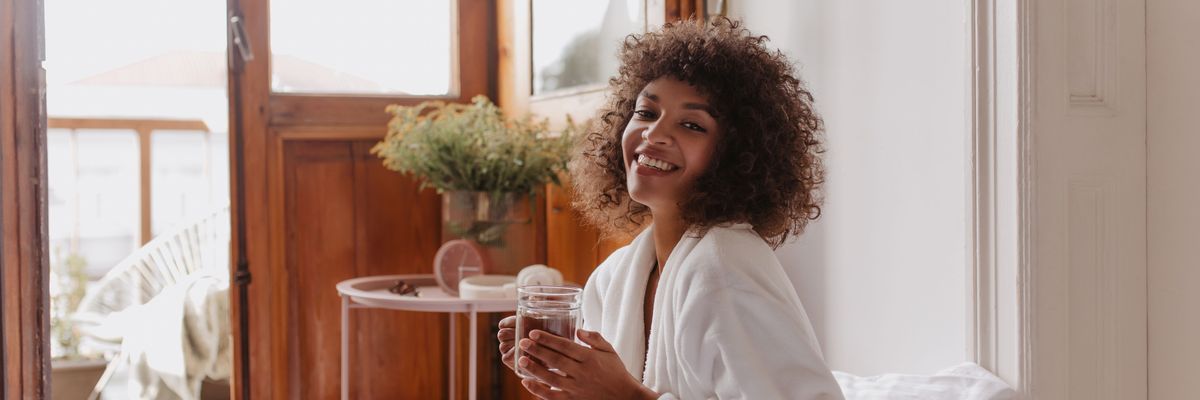
I don't know about y'all, but as I'm forever on this mission to grow out this hair of mine, I'm always discovering something new. Lately, something that I've been paying attention to is which season of the year typically gives me the most stress as it relates to maintaining length retention. The conclusion that I've come to is wintertime is a mutha. A part of the reason is because since the temperatures are cooler, I like to wear my hair out more; that can wreak havoc on my ends. Another challenge is I like to wear hats more often; since I'm a vintage gal at heart, some of my headwear isn't lined. And yeah, that's not good. Then there's finding the balance between how much moisture is too much and if I'm using enough protein at all. Ugh.
Unfortunately, in times past, not being aggressive in finding solutions to dilemmas like these resulted in my losing an inch or two due to dryness and breakage. But this year, I think I've got a handle on how to get—and keep—my hair wintertime ready. If you'd like to know what tips actually work for me, I've enclosed 10 of 'em below.
1. Get a Good Trim
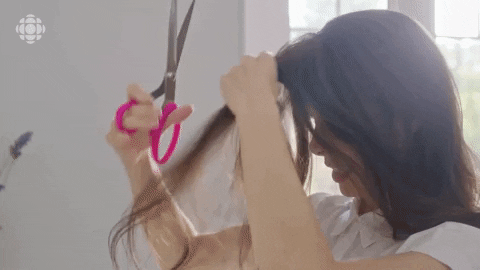
Trimming your hair does not make your hair grow longer. But what it does do is get rid of split ends, single strand knots and any of the breakage that can make your hair frizzy and uneven-looking. Listen, I hate trimming my hair as much as the next person, but I must admit that every time I do it, my hair is a lot more manageable and easier to take care of. Plus, when my ends are "right", that makes it less difficult for them to "catch" onto my sweaters, hoodies and blazers. So yeah, if it's been more than 12 weeks since you've trimmed your ends, set up an appointment with your stylist or at least invest in a good pair of shears so that you can do a little bit of trimming or dusting at home. Your ends and overall hairstyle will be forever grateful.
2. Deep Condition on a Weekly Basis
You would think, with all of the wetness that comes with winter weather (rain, snow, sleet), that dry brittle hair due to the atmosphere would be the last thing that we'd need to worry about. But actually, cold weather brings brisk winds, freezing temperatures and oftentimes a dip in humidity; less humidity equals less moisture. Not to mention the fact that most of us tend to crank up our central heating which can zap the moisture indoors as well.
One way to combat all of this is to deep condition your hair. If you're currently in the habit of doing it a couple of times a month, consider doing it once a week, just until it gets a little warmer outside.
If you're worried about "over-washing" your hair, using a sulfate-free shampoo and following up your deep conditioning treatment with a leave-in conditioner should compensate for any moisture that shampooing may take away.
As far as the kind of conditioners that are best, check out "Top 18 Deep Conditioners of 2018 for Naturally Curly Hair". Or, if you'd prefer to make some yourself, there are some cool DIY videos here, here and here.
3. Give Yourself a Protein Treatment
While I've been trying to figure out the keys to obtaining hair growth and retention, I've learned that one of the biggest mistakes a naturalista can make is not finding the balance between knowing when your hair needs more moisture vs. when it needs more protein. When your hair feels dry or looks frizzy, that is an indication that it needs moisture. But as far as protein goes, when your hair lacks elasticity, it feels "gummy", it's super brittle or you've recently color-treated your tresses, these are all indicators that you could probably stand to give yourself a protein treatment.
If you're wondering how often you should give yourself a protein treatment, every six weeks or so is usually the norm. You can either go with a popular product like Aphogee or you can make your own.
4. Apply a Hydrating Mask
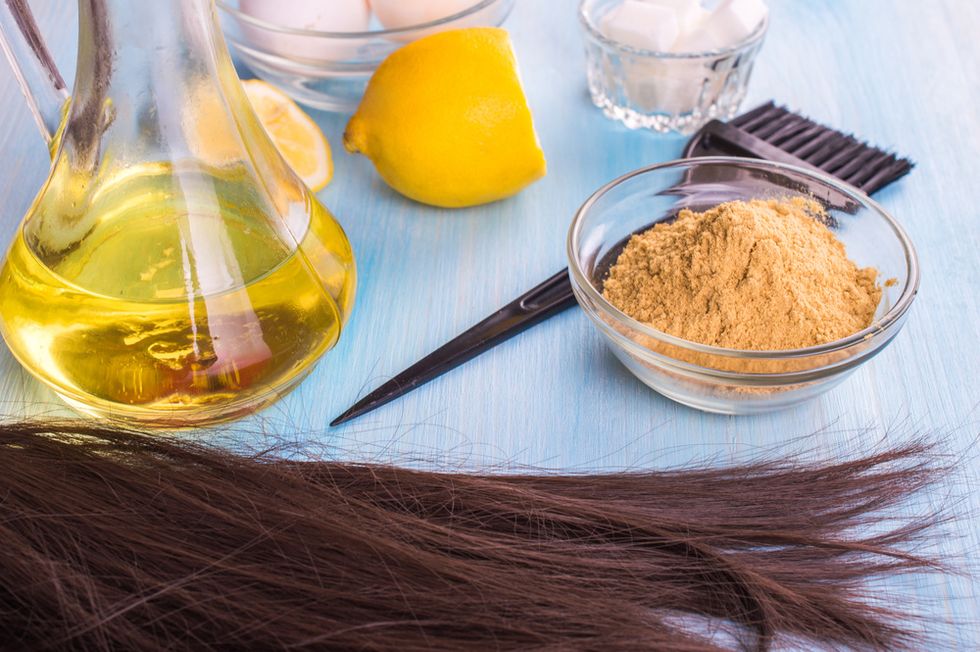
If you're committed to keeping as much moisture in your hair as possible this winter season, something else that you should do once a month is apply a hydrating mask to your hair. If you use them on a consistent basis, they will help your locks to retain moisture, while eliminating brittleness and frizzing, reducing the amount of product build-up on your hair, and making your hair feel softer and appear shinier too.
There are some hair masks that you can find at your local drug store or beauty supply store, but I recommend making some at your crib. If having less frizz is what you're after, mix two tablespoons of honey with two tablespoons of virgin olive oil. Heat the mixture on low in a saucepan for 30 seconds. Let it slightly cool and apply to freshly washed hair. Let it sit for 40 minutes and then rinse, first with warm and then with cool water (to seal your cuticles). If your hair is drier than you would like, mix a ripe avocado, a ripe banana, two tablespoons of pure Aloe Vera gel and a teaspoon of sweet almond oil. Apply it to your hair right after you shampoo and condition it. Let the mixture sit for 25-30 minutes and rinse with warm water. Both of these masks will have your hair feeling super soft and well-hydrated. Your scalp will feel nourished in the process too.
5. Seal Your Ends with Grapeseed Oil
Your ends are the oldest parts of your hair; that's why they need to be pampered the most. Whenever we forget this, that's why we aren't able to maintain length retention because, just think about it—your hair is always growing.
If you're not seeing any length, it's probably because your ends are constantly breaking off. One way to protect your ends during the winter season is to seal them on wash days and to also apply a little grapeseed oil to them every night (or every other night) before turning in.
The reason why grapeseed oil is such a good look is because it literally works as a natural sealant around your hair follicles. Also, since it penetrates your hair shaft so well, moisture is able to stay in your hair so that your strands won't become dry and brittle. Some other benefits of this particular oil is it's light, it fights dandruff and scalp irritation, and the antioxidants, Vitamin E, flavonoids and linoleic acid that's in grapeseed oil can help your hair to grow faster as well.
6. Be Careful with the Flannel
Anyone who knows me knows that I adore my bed and spending as much time as possible in it. And whenever wintertime rolls around, something that I can't wait to pull out are my flannel sheets. Not only are they cozy as all get out but using them means that I don't have to rely as much on my central heat to keep me warm; that ultimately results in lower electricity bills which is always a winner. If there is a downside to flannel, it's the fact that rolling around all night on them can definitely dry out my hair. Same thing goes for flannel sheets and, as far as winter wardrobes go, flannel shirts. So, if there is ever a time to wrap your hair up either with a satin or silk scarf, this is the time of year to do it. You also might want to only wear flannel bottoms because, our body temperatures change throughout the night and you don't want to sweat because you went to bed cold but woke up burning up. Oh, and if you've got some cute oversized flannel shirts that you want to wear and your hair is long enough to touch your collar, try and wear those when your locks are in a protective style or are up in a ponytail, just so that your ends won't end up constantly rubbing against them.
7. Pull Out Your Cover Ups
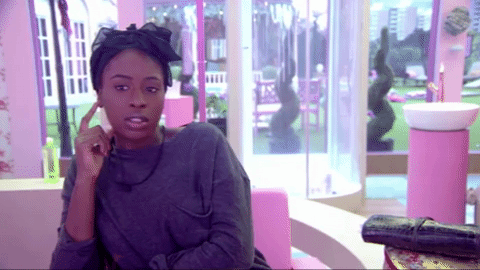
Something else that's really cool about the winter season as it directly relates to your hair is, if you don't feel like rocking a protective style, you can always wrap your hair up in a scarf, beret, beanie, fedora or even an ushanka if you want to. Not only are these stylish ways to protect your hair from inclement weather, they can also help to keep you from putting extra stress on your tresses via various heating and styling tools. Just make sure that if you're going to be wearing these a lot that you apply a light oil (like argan, avocado or sweet almond oil) to your hair in order to give it a little extra moisture. Also, if you do opt to wear a hat, make sure to follow this next step too.
8. Line Your Hats
Something I must admit that I have a pretty impressive collection of is hats. During this time of year, if I'm not rockin' a golf cap, I like to wear a wool brim. Brims are cute but man, between the drying out that wool does and the way hair tends to "catch" onto the fabric, they can give your hair all sorts of problems if you don't make sure that the inside of them are lined. If the hats that you currently own aren't already lined with satin, no worries. The internet is your friend and it offers up all sorts of instructional videos to show you how to line your hats on your own. Check out a couple of 'em here and here.
9. Avoid Certain Ingredients in Hair Products
I'm someone who likes to make a lot of my own hair products; that or I purchase some from Etsy. But if you're looking at your computer screen like, "Girl, ain't nobody got time for all of that", just make sure that before you run up into your local beauty supply store, you're aware of what ingredients will work against your hair rather than for it.
Some of those include isopropyl alcohol (it will dry your hair out); mineral oil and petroleum (they will wear your hair down and could potentially block your hair follicles); sulfates (they will strip the natural oils right out of your hair); sodium chloride (it can irritate your scalp) and synthetic colors and fragrances; they can also irritate your scalp and eventually lead to hair loss.
While we're on this particular point, also try and steer clear of any hair product that doesn't lead off with water as its first ingredient. Whatever a label shows first, that's what it has the most of, and nothing can moisturize your hair quite like water does.
10. Get a Humidifier

Shutterstock
Central heat may be convenient, but here are some signs that it's getting on your body's nerves—you wake up with chapped lips; your skin is dry and itchy throughout the night; you can't seem to get over a cold; your throat is irritated; your allergies keep acting up; you end up with nose bleeds or your hair is dry as all get out. The remedy? Add more humidity (which is simply water vapors) into your house and, more specifically, your bedroom. Since our bodies need somewhere between 40-60 percent relative humidity in order for us to be healthy and feel comfortable, it can only work in your favor to put a humidifier in your room during the winter season.
If funds are tight, a work-around is to place a pot on top of or in front of one of your vents so that moisture can hit the air that way. Your health will thank you for it. Come Valentine's Day, your hair will thank you for it too. Happy Hair Winterizing, y'all!
Want more stories like this? Sign up for our newsletter here and check out the related reads below:
I Tried 3 Types Of Gel On My Type 4 Natural Hair & Here's What I Learned
10 Natural Hair Products To Add To Your Routine
This Is Why Your Natural Hair Ain't Growin'
The Lazy Girl's Guide To Natural Hair
Feature image by Shutterstock
Did you know that xoNecole has a podcast? Subscribe on Apple Podcasts or Spotify to join us for weekly convos over cocktails (without the early morning hangover.)
- Winter Natural Hair Growth Tips - xoNecole: Women's Interest, Love, Wellness, Beauty ›
- Tips To Maintain Your Natural Hair This Winter - xoNecole: Women's Interest, Love, Wellness, Beauty ›
- What Your Hair Needs In Winter Cold Weather - xoNecole: Women's Interest, Love, Wellness, Beauty ›
- Hair Breakgage: Reasons Natural Hair Is Breaking Off - xoNecole: Women's Interest, Love, Wellness, Beauty ›
- Expert Tips To Prevent Hair Breakage - xoNecole: Women's Interest, Love, Wellness, Beauty ›
- How To Care For Natural Hair In The Winter ›
- Winter Moisture Protection for Natural Hair | 4C Hair Type | Day 6 ... ›
- 6 Winter Natural Hair Tips for Dry Hair - YouTube ›
- 9 Ways To Prep Natural Hair For Cold Weather, Because Snows And ›
- 17 Time-Saving Winter Hair Care Tips | Natural Hair Rules!!! ›
- The Best Winter Hair Care Tips for Curly and Natural Hair ›
- 10 Ways to Protect Natural Hair in the Winter – NaturAll Club ›
- 7 Things Your Natural Hair Needs This Winter | NaturallyCurly.com ›
This Is How To Keep 'Holiday Season Stress' From Infecting Your Relationship
Hmph. Maybe it’s just me, but it seems like there is something really weird happening in the fall season air (because winter doesn’t officially begin until December 21) that cuddle season is in full swing while break-up season is as well. In fact, did you know that break-ups are so popular during the holiday season that December 11 is deemed Break-Up Day?
The reasons why relationships shift around this time vary; however, I did both roll my eyes and chuckle when I read that a very popular one is because it’s an easy way to get out of getting one’s significant other a Christmas present. SMDH.
Anyway, I personally think that the less shallow folks out here may contemplate calling things “quits” or they at least distance themselves a bit from their partner (and what I’m referring to is serious relationships) due to all of the stress and strain that oftentimes comes with the holidays whether it be financial, familial, due to their tight schedules or something else.
Listen, I would hate for you and your man to miss the fun and happiness of experiencing this time of year, all because you are so overwhelmed or irritated that you can’t really enjoy it. That’s why I have a few practical tips for how to avoid allowing the typical holiday season stress from INFECTING your relationship.
Manage Your Expectations
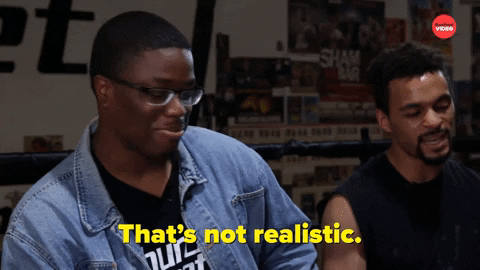 Giphy
GiphyUnmanaged expectations. If there is a main reason why the holiday season tends to be so stress-filled for so many people, I’d bet good money that this is the cause. And when you’re in a long-term relationship, expectations can manifest themselves in all sorts of cryptic and/or unexpected ways. You might have relatives who assume that you are going to be with them for Thanksgiving or Christmas when you have other plans in mind. You might be thinking that you are going to spend one amount for presents while your man is thinking something totally different. When it comes to scheduling, your signals may be crossed.
And you know what? To all of these scenarios, this is where clear and consistent communication come in. Don’t assume anything. Don’t dictate anything either. From now until New Year’s, mutually decide to check in once a week, just to make sure that you are both on the same page as it relates to the holidays and what you both are thinking will come along with it. The less blindsided you both feel, the less stressed out you will be. Trust me on this.
Set (and Keep) a Budget
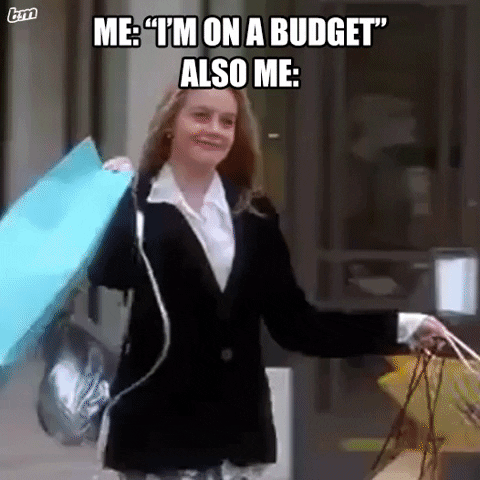 Giphy
GiphyOkay, so I read that last year, 36 percent of Americans incurred some type of holiday-related debt. Hmph. Last year, there was still some sense of normalcy in this country, chile, so I can only imagine what finances are gonna look like over the next several weeks. That said, since I don’t know a lot of people who don’t find being broke stressful, make sure that you and your bae set a budget and then stick to it this year — no ifs, ands or buts.
Because really, y’all — it doesn’t make sense to deplete savings and/or max out credit cards for a few days of giggles only to be damn near losing your mind because you don’t know how to make ends meet come Dr. Martin Luther King, Jr. Day.
And by the way, this tip doesn’t just speak to things like food and gifts; I also mean travel. If it doesn’t make a ton of sense (or cents) to be all over the place this year — DON’T BE.
Keep Matthew 5:37 at the Forefront
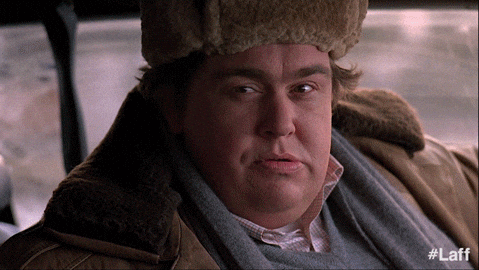 Giphy
GiphyIf off the top of your head, you don’t know what Matthew 5:37 says, no worries, here ya go: “But let your ‘Yes’ be ‘Yes,’ and your ‘No,’ ‘No.’ For whatever is more than these is from the evil one.” That verse right there? Oh, it’s a boundaries lifesaver! I say that because do you see “maybe” or “I’ll think about it” in there? Nope. LOL. It says that you should tell people “yes” or “no” and leave it at that — and that complements Anne Lamott’s quote, “’No’ is a complete sentence” impeccably well. Yeah, you’ve got to remember that anything beyond a yes or no to a request is privileged information; you don’t owe anyone details or an explanation.
Besides, if you are really honest with yourself, when someone asks you something and you give a “Umm, let me think about it” kind of reply, more times than not, you already know what your answer is going to be — so why not let you both off of the hook? Give your response. Commit to that. And let everyone (including yourself) get on with their lives and schedules.
I promise you that when it comes to those holiday parties, you are pissing more folks off by not RSVP’ing or doing so and not showing up than just saying, “Thank you but not this year” off the rip.
Remember That Your Personal Space Is Privilege Not a Right
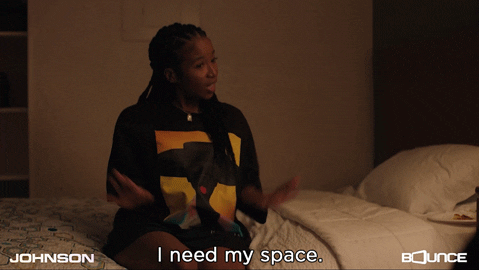 Giphy
GiphyA friend of mine recently bought a new house and invited me over to come see it. He’s a single man with no children, so as I was taking in all of the space that he had, especially as I walked through his finished basement, I joked about relatives coming to live with him. “Hell no” and “absolutely not” were pretty much his immediate responses as he went on to say that some folks even had the nerve to be offended when he told them that he had no intentions on taking DNA in.
Ain’t it wild how people think that your stuff is their right? And yes, that brings me to my next point. Your home is your sanctuary space. If you want to host folks this year — cool. If not, ALSO COOL. Please don’t let folks (family included) guilt you into how they want you to act or even into what they would do if the shoe was on the other foot. You are not them — and as one of my favorite quotes states, “If two people were exactly alike, one of them would be unnecessary.” (A man by the name Larry Dixon said that.)
Hell, my friends? They know that I am good for sending them random things that they need or even want all throughout the year. Coming over to hang out at my pace, though. Uh-uh. Chalk it up to being a card-carrying member of the ambivert club yet I like keeping my living space personal — and I sleep like a baby, each and every night, for feeling that way.
Always remember that your space, your time, your resources, your energy and shoot, yourself period (including your relationship), are all things that are your own. You get to choose how, when and why you want to share them. The holiday season is certainly no exception.
Cultivate Some “You Two Only” Traditions
 Giphy
GiphyIt’s not uncommon for some couples to hit me up after the holiday season to “detox.” Sometimes it’s due to the financial drama (and sometimes trauma) that they experienced. Sometimes it’s because they allowed their relatives (especially in-laws) to get more into their personal business than they should’ve. More than anything, though, it tends to be because they didn’t get enough quality time together and so ended up feeling “disconnected.”
Please don’t let that happen. Listen, I’m not even a holidays kind of woman and yet, I will absolutely sit myself down with some hot chocolate and chocolate chip cookies to enjoy a Hallmark holiday film or two. Aside from the fact that most of them are lighthearted and sweet, I also like that they usually focus on couples loving on each other amidst all of the holiday beauty and ambiance — which is something that all couples should set aside some time to do.
Maybe it’s a vacation. Maybe it’s a staycation. Or maybe it’s my personal favorite, A SEXCATION. Whether it’s for a few days, the weekend or even overnight — don’t you let the holidays go by without setting aside time for you and your man to celebrate one another. Don’t you dare (check out “Are You Ready To Have Some Very Merry 'Christmas Sex'?”).
GET. SOME. REST.
 Giphy
GiphyI once read that 8 out of 10 people get stressed out over the holidays and 3 out of 10 lose sleep during to it — and when you’re stress-filled and sleep-deprived, that can absolutely lead to hypersensitivity, making mountains out of molehills and even not being in the mood for sex.
Your relationship can’t afford to go through any of this, so definitely make sure to prioritize rest. I don’t care how unrealistic it might seem during this time, sleep should never be seen as a luxury; it will always and forever be a great necessity.
That said, try to get no less than six hours of shut-eye in (check out “6 Fascinating Ways Sex And Sleep Definitely Go Hand In Hand”) and even ask your bae to take a nap with you sometimes (check out “Wanna Have Some Next-Level Sex? Take A Nap, Sis.”). Not only will sleep help to restore your mind, body and spirit but, when it’s with your partner, it’s an act of intimacy that can make you both feel super connected, even in the midst of what might feel like chaos.
___
Holiday season stress is real. Still, never give it the permission or power to throw your relationship off. Put you and your man first and let the holidays be what they are gonna be, chile.
Let’s make things inbox official! Sign up for the xoNecole newsletter for love, wellness, career, and exclusive content delivered straight to your inbox.
Featured image by Shutterstock
Whew. Did you know that somewhere around 122 million Americans travel during the holiday season? Listen, I went to see my godbabies this past September and got caught up in a crazy ass traffic jam at BNA (the Nashville airport) that damn near has me considering air travel ever again — especially during this time of the year.
Besides, it’s not like it’s a written rule that you have to travel over the holidays. In fact, if you want to play it chill this year, why not enjoy a staycation instead? Although it might seem like it’s a “poor man’s compromise,” as you’re about to see, it actually…isn’t.
1. Go All Out with the Christmas Décor
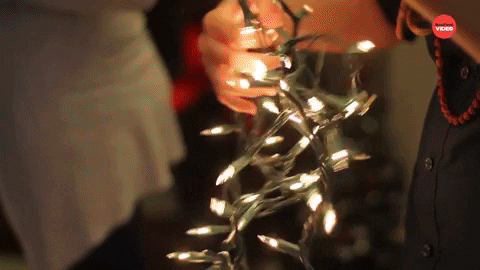 Giphy
GiphyThere is someone I know who is so obsessed with Christmas, she’s damn near annoying-borderline-terrifying. I’m. Not. Kidding. Yet hey, if you’re going to do a holiday-themed staycation (emphasis on “holiday-themed”), that’s kind of how you’ve got to be. Some décor ideas include:
- A fresh Christmas tree (is the most ideal) that is ultimately decorated
- Wreaths on outside and inside doors
- Garland (with twinkle lights) in predictable and unpredictable places
- Poinsettias
- Mistletoes
- Snow globes
- A stocking (with some of your favorite things in it)
- Fake snow
- Stars
- Angels
- Candy canes
- A BLACK Santa (LOL)
I mean, since you are going to be spending a lot of time at home, it can feel like a mini-winter wonderland if you are intentional about doing more decorating to your living space than you ever have before!
2. Buy a Couple of Christmas-Themed PJs
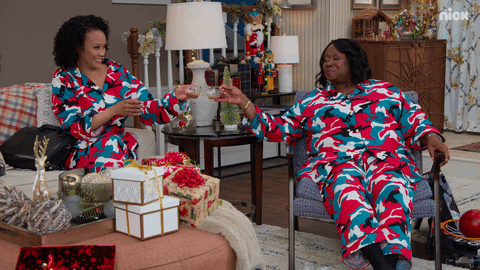 Giphy
GiphyWhile I was doing some research on a totally different topic, I happened upon an article that talked about the psychology behind why we should be intentional about what we wear to bed. When you stop to think about the fact that (hopefully) you are sleeping somewhere between 6-8 hours every night, it would make sense that things like the color and fabric of your sleepwear would have a real impact on you — even subconsciously.
Well, when it comes to Christmas décor, specifically, not only does it take you back to nostalgic memories, it can also boost your moods. So, aside from being on-10 with your Christmas décor, also invest in some Christmas-themed PJs. Since you’re going to be doing a lot of lounging around (RIGHT?), do it in something that makes you think about all of your favorite things about this time of year.
3. Cop Some Christmas-Scented Candles
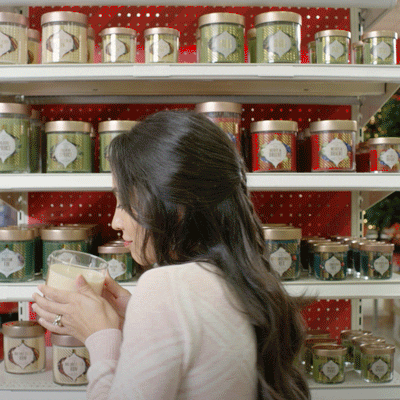 Giphy
GiphyThere really is no telling how many articles that I’ve written where I am singing the praises of scented soy candles. Candles are soothing, comforting and a very easy way to reduce stress. Also, since it gets darker quicker and for a longer period of time around this time of the year, candles provide a relaxing vibe to your home. Since it is Christmastime, go with scents that are reminiscent of the season:
- Cinnamon
- Vanilla
- Cranberry
- Apple
- Pine
- Frankincense and Myrrh
- Peppermint
- Cashmere
- Ginger(bread)
- Orange
- Sugar Cookies
- Sandalwood
- Cloves
- Cedarwood
- (Hot) Chocolate
Personally, one of my favorite candle companies is Goose Creek. Their signature collections will have your entire house smelling like a high-end bakery. No exaggeration.
4. Play Some Winter-Themed ASMR Sounds
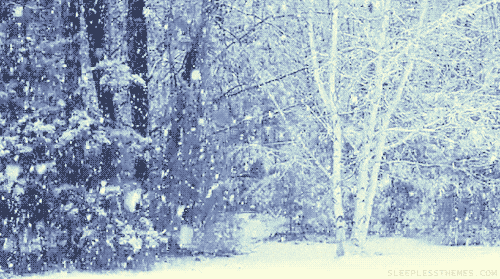 Giphy
GiphyI’m from Nebraska and my mother was a New Yorker. So, if there is one thing that I like, it’s seasons and that includes snow during wintertime. Unfortunately, Nashville is cray-cray when it comes to that. If, where you live, the weather is all over the place too (which is why I think it’s insane that some people still give pushback to global warming) and you would like for it to at least seem like you are in your own winter wonderland — invest in some fake snow to strategically place around your home.
Oh, and don’t forget to turn on some winter-themed ASMR sounds too. YouTube has videos that run for hours on end that feature blizzards and howling winds that really can make you feel like you are in the midst of an ice storm.
5. Host a Holiday Movie Marathon
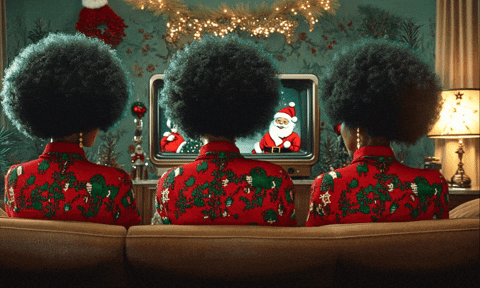 Giphy
GiphyOne thing to remember about a staycation is it doesn’t mean that you have to be alone or that the only people who can participate are the ones who live with you. Since a staycation is simply about staying close to home instead of traveling afar — absolutely consider having some of your favorite people over for a holiday-themed movie marathon. Shoot, Black America Web even did you a solid by publishing “25 Best Black Christmas Movies Of All Time;” plus, Tubi has a Black holiday hits section of indie films too.
Oh, and make sure to get creative with the Christmas-themed snacks. Some ideas? Some Kentucky-fried turkey tenders with cranberry hot sauce (recipe here), some Holiday Hot Spinach Dip (recipe here), some Grinch Kabobs (recipe here), some roasted pecans (recipe here) and some Pomegranate Guacamole (recipe here).
6. Spend a Night (or Two) at a Hotel or Vacation House
 Giphy
GiphyJust like you don’t have to be alone during a staycation, you also don’t have to be cooped up in your house the entire time. Get a change of scenery in your own city by spending the night in a hotel that you’ve always wanted to try out or renting a vacation house for you and some of your folks to hang out in during the time between Christmas and New Year’s Day. I have a “love little sister” who does this randomly when she needs a break from her work as a therapist. She says that it’s damn near like taking a trip (and she has PLENTY of passport stamps; trust me).
7. Have Brunch or Dinner at a Christmas-Themed Restaurant
 Giphy
GiphyIf nothing puts a bigger smile on your face than the thought of DoorDashing meals and barely even touching your stove during your staycation — hey, I am right there with you. Do consider going out to brunch or dinner during your chill time, though. It’s another way to bond with people and create some current holiday memories. And if you’ve got a bae and you opt for dinner, it can be a wonderful type of Christmas-themed date.
8. Go to a Holiday-Themed Concert
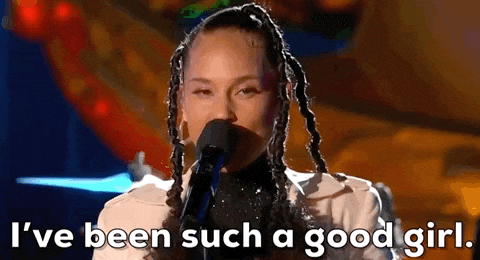 Giphy
GiphyBeing that I got my start as an entertainment writer, hear me when I say that I’m not someone who just has to go to a live concert every chance that I get. Oh, but baby, when I saw that El DeBarge was doing a City Winery tour and he was going to be here right before Christmas — I booked myself a ticket quick, fast and in a super-duper hurry! Shoot, I didn’t even want to go with someone because I plan to give him and that falsetto voice of his my complete and undivided attention. LOL.
I don’t know what it is about the holiday season that makes live music that much more enjoyable — but if there is a concert that features one of your favorite artists happening right through here, consider that to be a cool way to “tour your city” while cultivating a really awesome memory at the same time.
9. Also, Go Ice Skating
 Giphy
GiphyOne of my fondest memories of time with my father is going ice skating. We actually would do it in the summer (because that is when I would visit him) and, every year, he would get me a new ice skating outfit. Even now, when I watch someone ice skate (even in movies; like in the classic movie Garden State), I will have warm fuzzies.
Anyway, if you’ve never been before, go. If it’s been forever since you have, also go. There is something that is very sweet and so signature Christmas about it. Plus, it’s a top-tier form of exercise.
10. Take a Christmas Lights Tour
 Giphy
GiphyAnother one of my favorite Christmas memories is driving through neighborhoods and looking at the Christmas lights. And just like a Christmas concert can be a form of hometown touring, so can doing this if you decide to choose a couple of areas where you’ve never really been or rarely frequent.
Now are you excited about the thought of experiencing a holiday-themed staycation?
I thought you would be. ENJOY!
Featured image by Shutterstock



